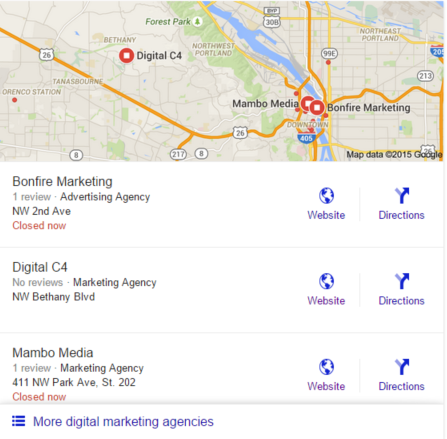
Google has been in the news a lot this week! The company’s recent announcement that they created a parent holding company, Alphabet, has been dominating the headlines over the last few days. However, lesser known changes include their quiet separation from Google+ and many business services changes which will have a huge impact on local SEO. We’ve compiled a roundup of recent changes and how they can impact businesses and websites.
What’s the Deal with Alphabet?
Breathe easy! The Alphabet announcement is a corporate restructuring move and should have no immediate or direct impact on your business. Alphabet will act as an umbrella parent company to help organize the company’s portfolio of businesses including Google, Nest, Zagat and more. Why would Google make this move? Google started off an internet search company. Over time, they grew to launch (and acquire) other businesses and services that aren’t directly related to the original core business. For example, Nest Labs is a home automation producer of “smart” home products like Wi-Fi enabled thermostats and smoke detectors. There’s also Calico, an R&D biotech company focused on understanding (and combating) age related diseases.
The development of Alphabet means Google realized they had to grow up. They’ve outgrown their “startup” model and, in order to properly mature their various offerings, they have restructured their business to give each unique company their own support and breathing room.
What Else? HUGE Google Local Shakeup!
If you’re a local business brace yourself. Things just got a lot more competitive! Google has made some major changes that will likely affect both online and brick-and-mortar local businesses.
The 7-Pack Shrinks to 3-Pack
What does this mean? Previously, when you searched for a service, Google would display seven local business in search result. Now, Google has limited the number of businesses displayed to just three. Listings in the 7-pack have always given a boost in search results because they appear before the organic results do. Shifting from a 7-Pack to 3-Pack means local search is now much more focused.
This switch will likely impact a significant amount of businesses who rely on local search. Google is known for frequently testing different ways to display search results, and some appearances of the 3-Pack arose towards the end of 2014. Google has now made this switch both in the US and internationally, which follows their pattern of a feature roll out rather than a small sample test.
Hey Mambo… How Do I Get My Business in the 3-Pack?
In short, you must pay attention to Location (your business must be within 20 miles of the searcher), Social Signals (especially Google+), and Reviews (see why Google’s Zagat purchase might make sense?).
Dig into Google+ more here. And note the following, from MOZ.com.
“Given that your customers will be interacting within a series of Google interfaces, it is now more important than ever that your Google-related marketing be as flawless as possible.”
We’ll go into detail on getting into the 3-Pack more in our blog, but in the meantime, make sure all the information in your Google My Business Dashboard (formerly Webmaster Tools) is complete.
(Ping Mambo if you need help anywhere within Google’s ecosystem or management tools… we can help!)
But Wait! There’s More! Addresses & Phone Numbers Removed
One major benefit for businesses who were able to rank in the “Pack” was the ease with which users could access key information like a business’ phone number, Google Maps location, reviews, etc. without leaving the search results to visit another site.
The new 3-Pack system removes the exact address and phone number of a business. The user must click through the link of the Pack listing which will take them to a Google Map view to get that level of detail. On mobile devices users are offered a “Call” button for each listing.
This evolution is likely indicating how Google is adapting to the way users have changed their search habits. Because they offer a map for people interested in a specific address/location from mobile, it makes sense to make it easy for people to call.
Clicks on 3-Pack Listings Lead to Even More ‘Show More’ Results
Once the user does click through on one of the 3-Pack listings they’re shown not only that listing’s information but 20 other listings towards the left. While it’s not pretty to look at, it does offer the user more options beyond the three initial results. What really stands out in this stacked view are listings with reviews and star ratings.
So develop your plan accordingly. How can you generate authentic reviews for your business?
Store Hours
House of operations have been added to listings and are more easily visible than in the previous versions. This is also for mobile users, who are literally searching at the point of purchase, on their way to your store.
Google+ Links Removed
Many businesses found it frustrating they were forced to sign up for a Google+ page when Google+ Local launched in 2012. Now, the link to the business’ Google+ listing has been removed in this new view.
A little hindsight helps. In an attempt to grow adoption of the use of their social media platform Google kind of forced Google+ upon their users. Overtime, Google probably noticed that businesses created the profiles, but had no interest or didn’t have the resources to manage it as a social platform.
It’s still a good idea to optimize your business’ Google+ page as it seems to be one of the many factors in Google’s algorithm. (No one outside of Google knows for sure). We don’t know yet if they’ve removed it from ranking considerations.
As we’ve noted… continue to encourage people to Review and Circle your brand page as that still sends strong signals to Google’s algorithms and can differentiate your listing from competitors.
“Google Reviews” Renamed to “Reviews”
Google is known for attaching its name to their products and services but this time they’ve removed it to simplify things. Again, a little history in perspective: when they first introduced reviews in the listing view they were pulling it from 3rd party review sites like Manta. When they built out Google+ they began allowing users to review from their profiles and then Google solely displayed those reviews.
It’s been long enough now that most people understand where the reviews are coming from and probably have already forgotten they were once sourced from 3rd party sites.

Google+ Reincarnation…Again
Kudos to Google for finally realizing that forcing products on users was not going to get people to use them! They hinted at these major during an interview last year with Sundar Pichai, when he discussed breaking off components of Google+ to become their own products. We now know of these components as real products, Google Hangouts and Google Photos and Streams.
(At that time, Pichai was Google’s head “Products” guy, but he has now been newly promoted CEO to Google, Inc. as a result of the formation of Alphabet).
Google’s recent blog post explains that over the next few months, users can expect to see more major changes:
1. A more focused Google+ experience with Google+ Collections and other migrations of features to more relevant products like location sharing in Hangouts.
2. The ability to use Google without a Google+ profile. This means you will be able to perform searches on Google and YouTube without your Google Account! They’ll also be making the process to manage/remove the Google+ they forced you to create (whoop!). YouTube will be the first big service where users will be able to experience the “divorce.”
This does not mean Google has decided to ditch Google+. Instead, they are admitting their failures and they are willing to invest in areas of the service that people did enjoy rather than have it compete with Facebook and Twitter when they didn’t offer anything unique enough for people to transition their regular social media use to them.
One area Google+ did excel at was be a place for people to find shared interests. “Communities” was a popular feature and they do a great job at bringing people together when compared to Twitter and Facebook. Google+ will be growing this feature and it will be interesting to see what the platform will evolve to become once all the changes are said and done.
Marketers have long joked about when Google might abandon the Google+ project but it’s clear with all the changes they’ve made over the years they’re committed to it. This product is probably their best example of their “failing fast” playbook; to create bold and innovative experiments, see how users respond, and further develop the success and cut the failures.
For Marketers, it’s still important to consider Google+ in your social media efforts. Optimizing your brand’s profile can help in SEO and SEM efforts; and making sure to connect with your customers and elicit their feedback is continuously important.
With continued management, great content and a strategic marketing plan—you can leverage these changes to grow your business and influence. Get in touch with Mambo to find out how we can help.




Pingback: Everything You Need to Know About the New Google Possum Update | Mambo Media